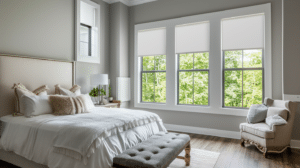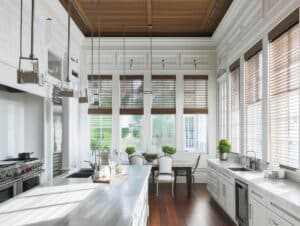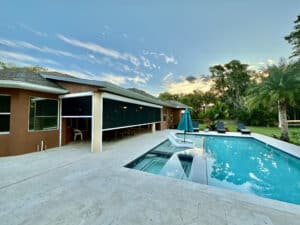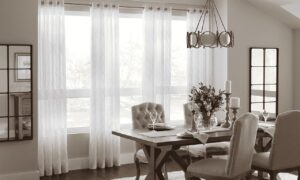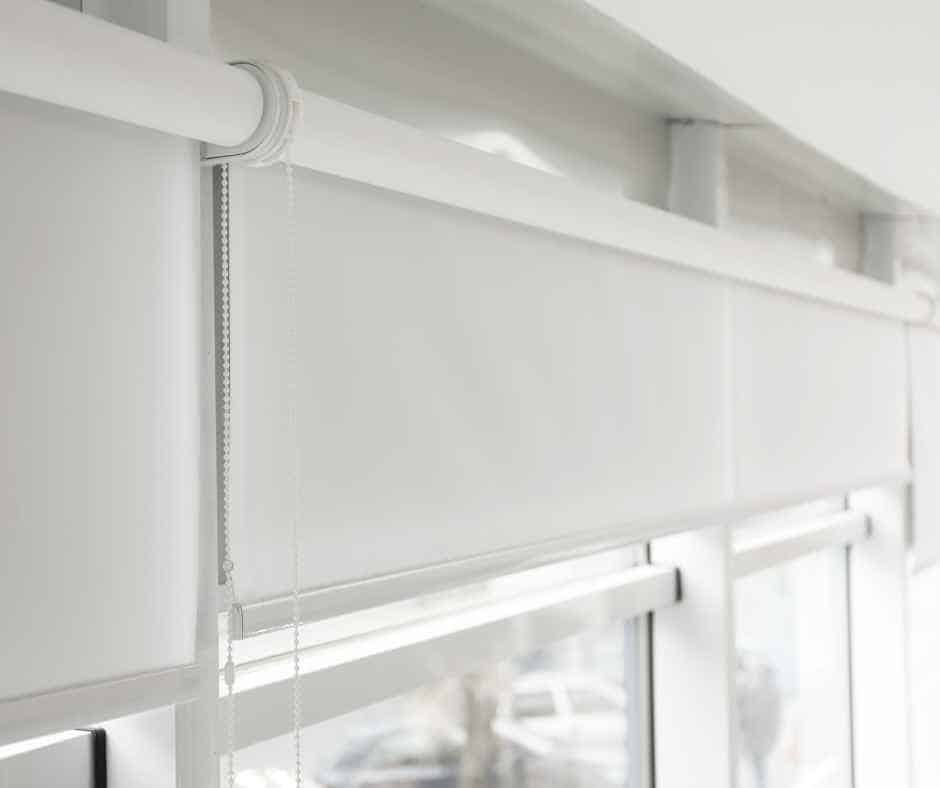
Thermal Performance Showdown: Cellular Shades vs Roller Shades
September 19, 2025
Buy 1 Get 1 50% OFF
Everything*
Request Free
In-Home Consultation
When it comes to keeping your home comfortable and energy-efficient, your window treatments play a bigger role than you might think. As energy prices rise and homeowners look for more sustainable ways to manage heating and cooling, window shades have become more than just a design element—they're a functional tool. The right shade can help reduce drafts, control sunlight, and insulate your space year-round. Two of the most popular styles in the thermal performance conversation are cellular shades and roller shades, each offering different benefits. But which one performs better when it comes to keeping the heat in (or out)?
In this blog, we’ll compare both options—breaking down insulation value, energy savings, style, and maintenance—to help you choose the best shade for your needs and climate.
Why Thermal Performance Matters in Window Shades
Windows are one of the most common sources of heat loss in winter and heat gain in summer. Even high-quality windows can allow significant energy transfer, making it harder—and more expensive—to maintain comfortable indoor temperatures. That’s where thermally efficient window treatments come into play. By adding an extra layer of insulation or solar protection, the right shades can dramatically reduce the workload on your HVAC system and lower your monthly energy bills.
Thermal performance isn't just about comfort—it’s also about efficiency and long-term savings. Well-insulated windows reduce the need for constant heating or cooling, which can extend the life of your HVAC system and reduce your home’s carbon footprint. They can also prevent interior fading caused by UV rays, improve acoustics, and reduce condensation issues that lead to mold or mildew.
Ultimately, selecting window treatments with thermal performance in mind means you’re not only designing a beautiful space—you’re building a smarter, more sustainable one. In the next sections, we’ll explore how cellular and roller shades measure up in this area and help you decide which is right for your home.
What Are Cellular and Roller Shades? A Quick Overview
Before we dive into thermal comparisons, it’s important to understand the structure and function of each shade style. Though both are popular and widely used, cellular and roller shades differ greatly in how they’re built—and that difference directly affects their performance when it comes to insulation and comfort.
Cellular Shades: Engineered for Insulation
Also known as honeycomb shades, cellular shades are made from a structured fabric that forms small air pockets, or “cells,” when viewed from the side. These pockets trap air between the window and the room, acting as a thermal buffer that helps regulate indoor temperature. They’re available in single-, double-, and even triple-cell designs, with each added layer improving insulation. This air-trapping design is the main reason cellular shades are so often recommended for energy efficiency.
Beyond insulation, cellular shades also offer excellent light filtering and privacy control, depending on the material you choose. They’re available in a variety of opacities—from sheer to blackout—and their clean, pleated appearance adds texture without visual clutter. They’re especially useful for rooms that experience extreme temperatures or require quiet and privacy, such as bedrooms or offices.
Roller Shades: Sleek, Modern, and Versatile
Roller shades are one of the most straightforward window treatments available. Made from a single sheet of fabric that rolls up into a compact headrail, these shades offer a clean, minimal look that works well in modern or contemporary spaces. While they don’t have the same insulating structure as cellular shades, they can still offer thermal benefits—especially when made from solar fabrics or those with heat-reflective backing.
What roller shades lack in insulation, they make up for in design flexibility. Available in a wide range of colors, patterns, textures, and opacities, they’re easy to customize and layer with other treatments, like drapes or valances. They’re ideal for homeowners who want simple, stylish solutions without added bulk.
Comparing Insulation Power: Cellular vs. Roller Shades
When it comes to thermal performance, not all shades are created equal. While both cellular and roller shades can help improve comfort and energy efficiency, their construction and materials play a major role in how effectively they insulate your home. Understanding how each shade style handles temperature control can help you choose the right solution for your specific needs and environment.
How Cellular Shades Perform Thermally
Cellular shades are designed with insulation in mind. Their signature honeycomb structure traps air in layered pockets between the window and your interior space, which reduces heat transfer in both directions. During the winter, these pockets help keep warm air from escaping; in the summer, they minimize heat gain from sunlight streaming through the glass. This built-in insulation can significantly improve your window’s R-value—the measure of resistance to heat flow—which helps reduce energy use and maintain steady indoor temperatures.
Because of this performance, cellular shades are especially useful in rooms with large windows, drafty exposures, or extreme seasonal temperatures. Double-cell and triple-cell models offer enhanced thermal efficiency, making them ideal for homeowners focused on energy savings and year-round climate control.
How Roller Shades Handle Heat and Cold
Roller shades, on the other hand, provide a lighter layer of protection. They don’t have built-in air pockets, so they don’t trap heat or cold in the same way cellular shades do. However, certain roller shade fabrics—especially those with light-reflecting or UV-blocking properties—can still contribute to thermal performance. These fabrics work by reducing solar heat gain, keeping rooms cooler on hot days and protecting furnishings from sun damage.
Roller shades are most effective thermally when paired with other treatments, like lined curtains or valances. While they won’t boost insulation as much as cellular shades, they can still contribute to energy efficiency—particularly when used strategically on sun-facing windows.
Additional Benefits Beyond Temperature Control
While thermal performance is a key factor in choosing window treatments, there are several other benefits worth considering. Both cellular and roller shades offer added value beyond insulation—each in their own way. From sound reduction to style versatility, the right shade can improve not just how your home feels, but how it functions.
Noise Reduction
Cellular shades hold a clear advantage when it comes to minimizing outside noise. Thanks to their multi-layered structure and the air pockets between cells, they naturally absorb sound. This makes them a smart choice for bedrooms, nurseries, or offices in busy neighborhoods or near street traffic. Roller shades, in contrast, are typically made from a single layer of fabric and offer little to no sound absorption. While they can slightly soften ambient noise, they won’t provide the same quieting effect as cellular shades.
Light Control and Privacy
Both shade types offer a range of light control options—from sheer to blackout—but their effectiveness varies depending on the materials used. Cellular shades generally excel at blocking out light, especially when paired with a blackout liner. Their structured fit also helps eliminate light gaps along window edges, which is ideal for media rooms or anyone needing total darkness for sleep.
Roller shades offer more flexibility in layering and pairing. Dual roller systems, for example, allow you to switch between sheer and blackout fabrics in one mount. However, they tend to allow more light seepage around the edges unless installed with side channels or layered with curtains. If full blackout isn’t a priority, roller shades provide stylish, easy-to-use options for managing both light and privacy.
Style and Customization
If your priority is design flexibility, roller shades have the upper hand. They’re available in an endless variety of colors, patterns, textures, and materials, allowing you to tailor them precisely to your room’s aesthetic. Whether you prefer bold prints or understated neutrals, roller shades offer more opportunity for creative expression.
Cellular shades, while available in a range of fabrics and opacities, tend to have a more uniform look. Their strength lies in function and subtle design. They work beautifully in minimalist or transitional spaces where comfort and performance are the primary goals, but their visual impact is more understated compared to roller shades.
Cost, Installation, and Maintenance Considerations
In addition to performance and design, it’s important to consider the practical side of your window treatment investment. Budget, ease of installation, and long-term maintenance can all influence which shade style is right for your home. While both cellular and roller shades are accessible to most homeowners, their differences become more noticeable when factoring in cost and upkeep.
Price Comparison
Cellular shades are generally more expensive than roller shades. Their multi-layer construction, energy-saving capabilities, and custom-fit options often place them in a higher price bracket. The investment can be worthwhile, particularly if your goal is long-term energy savings or enhanced insulation in high-traffic rooms.
Roller shades are typically more budget-friendly. Their streamlined design and simpler materials make them easier and cheaper to manufacture and install. For homeowners looking to update multiple rooms on a tighter budget—or those prioritizing style over insulation—roller shades offer an attractive and affordable solution.
Ease of Installation
Both types of shades are relatively straightforward to install, especially when purchased in standard sizes. However, cellular shades can require more precise measurements due to their bulk and layered design. A tight fit is essential to maximize insulation, so professional measurement and installation may be beneficial—especially for larger or non-standard windows.
Roller shades, with their low-profile mount and simple mechanics, are typically easier to install and adjust. Their clean structure makes them ideal for DIY projects or quick room refreshes. For homes with many windows or limited installation experience, roller shades may present fewer complications.
Maintenance and Durability
Maintenance can vary significantly between the two. Roller shades are generally easier to clean—most only require occasional dusting or a light wipe with a damp cloth. Their single-layer design means fewer crevices for dirt or debris to accumulate, and they tend to be more resistant to daily wear.
Cellular shades, while durable, require more careful handling. Their fabric pockets can trap dust, making gentle vacuuming or compressed air cleaning necessary. They're also more susceptible to creasing or crushing if mishandled, particularly in homes with pets or children. While they hold up well over time, they do demand a bit more attention to stay in good shape.
Which Shade Should You Choose?
Deciding between cellular and roller shades ultimately comes down to your home’s needs, your style preferences, and the level of functionality you're looking for. Both options offer unique benefits, and each excels in different areas. By considering your priorities—whether it’s energy savings, aesthetics, or ease of maintenance—you can confidently choose the shade that fits your space.
If insulation and thermal performance are your top concerns, cellular shades are the clear winner. Their structured design traps air and helps maintain consistent indoor temperatures, which can lead to lower energy bills and greater year-round comfort. They’re especially well-suited for homes in extreme climates or rooms with large windows, drafty exposures, or significant sun exposure.
On the other hand, if you’re looking for a sleek, modern look with flexible styling options, roller shades are an excellent choice. Their simple, low-profile design complements contemporary spaces, and the wide variety of fabrics and patterns makes them easy to customize. While they offer less insulation than cellular shades, they can still help manage sunlight and glare—particularly when made with solar or light-reflecting materials.
For some homeowners, the best solution might be a layered approach—using cellular shades in bedrooms and living areas for comfort and quiet, while installing roller shades in kitchens, bathrooms, or home offices for style and ease of use. You can even combine both styles in a dual shade system to take advantage of the strengths of each.
Choosing the right shade isn’t just about appearance—it’s about improving your home’s comfort, efficiency, and function in a way that feels seamless and intentional.
Wrap-Up: Comfort, Efficiency, and Style Start With the Right Shade
Your window treatments do more than dress up a room—they play an important role in how your home feels, functions, and performs throughout the year. Whether you’re battling summer heat, winter drafts, or just trying to reduce energy costs, the right shades can make a noticeable difference. Cellular shades lead the way in insulation and thermal performance, offering comfort and savings where it counts. Roller shades shine in their versatility, design flexibility, and ease of maintenance.
No matter your priorities—energy efficiency, modern style, or a combination of both—there’s a solution that fits your space. Taking the time to choose the right window coverings can help transform your home into one that feels more balanced, beautiful, and better equipped to handle the seasons.
Ready to find the perfect shades for your home? Contact Zinga’s Home Solutions today to explore custom options that match your style and maximize your comfort year-round.


Recent Posts
Why Your Motorized Blinds Stutter or Stall: Troubleshooting 5 Common Failures
Thermal Performance Showdown: Cellular Shades vs Roller Shades
The Ultimate Design Checklist for Coordinated Indoor & Outdoor Shades
Categories
Download our Motorized Pergola Guide
Looking for inspiration? Download our free feature packed pdf and see what all options you can get in your pergola.
Table of Contents
- Why Thermal Performance Matters In Window Shades
- What Are Cellular And Roller Shades? A Quick Overview
- Cellular Shades: Engineered For Insulation
- Roller Shades: Sleek, Modern, And Versatile
- Comparing Insulation Power: Cellular Vs. Roller Shades
- How Cellular Shades Perform Thermally
- How Roller Shades Handle Heat And Cold
- Additional Benefits Beyond Temperature Control
- Noise Reduction
- Light Control And Privacy
- Style And Customization
- Cost, Installation, And Maintenance Considerations
- Price Comparison
- Ease Of Installation
- Maintenance And Durability
- Which Shade Should You Choose?
- Wrap-up: Comfort, Efficiency, And Style Start With The Right Shade
What Products Are You Interested In?

Shades Made Simple.
STEP 1: Complimentary In-Home Consultation
We bring sample products & fabrics directly to your home so you can see and feel the products in your home.
STEP 2: Precise Measuring & No Pressure Quote
We take precise measurements of all your windows and provide you a no pressure quote at the time of your consultation.
STEP 3: Hassle Free Installation
Installation completed by Zinga's employee who are experts in their craft. Free yourself of the stress of installing.
Building a Home?
Building a home can be stressful enough, let us take the burden of window treatments off your hands. We will meet with you after your drywall is complete and can install as soon as you move in!







Who Is Zinga’s?
Zinga’s has been offering window treatments for 25 years and has grown 25% year over year! How did we do that? Simple, we’ve put our customer first. We genuinely love our customers and giving them great service. We want to wow our customers and when you wow your customers they give great referrals. See our over 2000+ reviews, our customers speak for themselves!
Learn More About Zinga's


